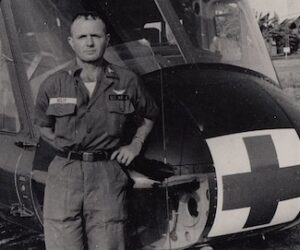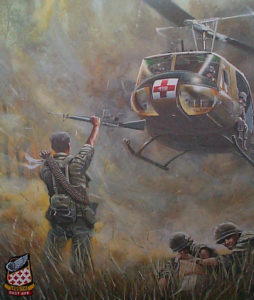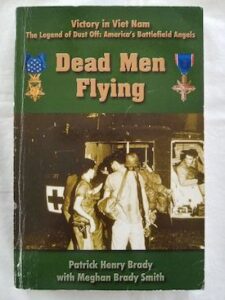“When I have your wounded.”
 Those words set the standard and example for generations of Dustoff crews, which provided helicopter aeromedical evacuation from the battlefield. They were also the death rattle of Maj. Charles Kelly. In terms of lives saved, his sacrifice was perhaps the most productive U.S. combat death ever. Kelly’s story may be instructive in demonstrating the shabby state of evacuation and care of wounded warriors today.
Those words set the standard and example for generations of Dustoff crews, which provided helicopter aeromedical evacuation from the battlefield. They were also the death rattle of Maj. Charles Kelly. In terms of lives saved, his sacrifice was perhaps the most productive U.S. combat death ever. Kelly’s story may be instructive in demonstrating the shabby state of evacuation and care of wounded warriors today.
A World War II veteran, Kelly was in command of the 57th Medical Detachment (Helicopter Ambulance) in Vietnam in 1964. At the time, the 57th covered Vietnam with five UH-1 helicopters, better known as “Hueys.” The primary mission was recovery of U.S. casualties. Nearly 16,000 GIs were in country, mostly as advisers, and they suffered few casualties. Thus, the 57th did not fly a lot.
Although patients had been moved by helicopter in World War II and Korea, there was no doctrine on the control and use of Dustoff in combat. Kelly’s boss, Brig. Gen. Joe Stilwell (son of the famous “Vinegar Joe” – we called him “Cider Joe,” but not to his face), had put the 57th helicopters under a transportation unit. This was a scheme doomed to fail, and it quickly did. The transportation guys were not trained as medics; that’s why they were called transportation soldiers. A helicopter ambulance is a medical resource, and all medical resources had been under medical control since the Civil War.
But Stilwell was determined to control the 57th birds. Shortly after Kelly’s arrival, Stilwell announced that he would use portable red crosses for medical missions and remove them for ash-and-trash missions. Kelly was outraged, and the two men went toe-to-toe. Stilwell said he would take his case to the surgeon general, who was his friend. Kelly replied that he might be a friend, but he was no damn fool. Kelly had been shot and almost died in World War II. He was morally and physically fearless. He had also been court-martialed three times and cared more about doing what was right than about his career.
I was in the unit when Kelly returned from his meeting with Stilwell. After warning that the higher-ups did not wish us well, he said that if we were to save Dustoff we had to prove we could rescue patients better than anyone else. He led the way, and we tried to follow. Our helicopters were moved to the areas of heaviest combat. Kelly marketed us, covering the countryside to tell our advisers that we were there for all casualties, day and night – and on the battlefield. Up to this time there had been little night flying. Reaction time is immeasurable in life-saving. Why must a patient wait for sunup when helicopters fly just as well – actually, better – at night, and the crew is safer from enemy fire?
Our casualty load increased significantly, breaking all previous records. Kelly became a legend, flying up to 150 hours a month. Entire villages turned out for his pickups, and a Pulitzer Prize-winning writer began covering him. Because our night missions were unprecedented, many actually thought that Dustoff was specially trained for night flying. One commander ordered a study into how we did it, which concluded that night operations were too dangerous. But Dustoff defeated those dangers every night.
Dustoff pilots, of course, were not specially trained. But through repetition, we became specialists in combat pickups at night, in weather and under fire. Through trial and error, we found ways to get patients with an alacrity previously unknown. If we encountered a situation beyond our capability we could call Kelly, but we never left a patient in the field; the welfare of the patient was our universe. We were a free-enterprise operation. Individual initiative ruled. We determined the risk (although I don’t remember ever hearing that word) by launching immediately and flying to the site. We had our own radio frequency and call sign and dealt directly with the grunts at the pickup site. There were no middlemen. Although we had three categories of patients – urgent, priority and routine – we responded to all calls instantly if we had the resources. This is the only way to prevent overclassification. It was unheard of to use two ships – a “gaggle” – or to waste time waiting for gunships except in extreme situations. Area security was undefinable, and a waste of time, between grunt and crew. We set a simple definition: stand up and help us load, and we will come in.
The issue of portable red crosses was still pending in late June 1964 when, as Stilwell was leaving country, Kelly presented him with a plaque listing our tail numbers. “Here, General,” Kelly said.
“You wanted my helicopters so damn bad, take them.” Stilwell smiled.
The issue was decisively settled a few days later.
 On July 1, Kelly was called into a supposedly secure area for an urgent U.S. patient. As he came to a hover, the enemy – mixed in with friendlies, as they often were – cut loose. The friendlies screamed at Kelly to get out. He replied stubbornly, “When I have your wounded.”
On July 1, Kelly was called into a supposedly secure area for an urgent U.S. patient. As he came to a hover, the enemy – mixed in with friendlies, as they often were – cut loose. The friendlies screamed at Kelly to get out. He replied stubbornly, “When I have your wounded.”
He then curled up from a single bullet shot right through his heart, the 149th American to die in Vietnam. The ship curled with him and the rotors beat it to pieces.
The entire U.S. and Vietnamese hierarchies attended Kelly’s funeral. Stilwell wept when told of his death. In a December 1966 McCall’s article titled “A Gift of Love,” Gen. William Westmoreland chose Charles Kelly out of thousands as a beautiful example of “the greatness of the human spirit.” He said Kelly was “a living legend” who stood out among those who gave “America more than they have taken from her … for when the going gets rough, and an extra ounce of effort is needed, Maj. Kelly’s last words still shine brightly: ‘When I have your wounded.’”
We never heard again of portable red crosses, and more helicopter ambulance units were programmed for Vietnam. Westmoreland agreed that we could do our mission better than anyone else, and we kept the resource. The medical helicopter was firmly under medical control, as it should be.
Inspired by Kelly, Dustoff became the most revered and effective battlefield operating system in Vietnam, with close to 1 million souls rescued and unprecedented survival records. Indeed, Dustoff did the most dangerous flying in Vietnam, with crews readily willing to risk their lives at any time for the grunts who risked theirs every day.
In the words of Gen. Creighton Abrams, Army chief of staff from 1972 to 1974, “A special word about the Dustoffs … Courage above and beyond the call of duty was sort of routine to them. It was a daily thing, part of the way they lived. That’s the great part, and it meant so much to every last man who served there. Whether he ever got hurt or not, he knew Dustoff was there.” And Dustoff continued to perform magnificently well beyond Vietnam, in Operation Just Cause in Panama, Operation Desert Storm, and in Iraq and Afghanistan.

498th Med-Evac – Dust Off
Dustoff’s unique qualities were spectacularly evident in the famous Bat 21 tragedy in Vietnam, where Dustoff was absent. The Air Force spent 11 days, at the cost of 11 lives and several aircraft, trying to rescue one man. They called it their largest ever search-and-rescue mission, but there was no search. They knew where he was and had radio contact. It is hard to imagine that there was a man on the ground moving about for 11 days, in radio contact, and no helicopter could pick him up. Any Dustoff crew would have had the man out posthaste as they had thousands of others in the same terrain.
With the formation of the Aviation Branch, a Stilwellian effort was made to eliminate Dustoff aviators and absorb the mission. It failed because the leadership – including Gen. John Wickham, Army chief of staff from 1983 to 1987, and Gen. Norman Schwarzkopf – had experienced and knew the value and skill of Dustoff as it was designed.
By 2005, most if not all of the vast aviation skill from Vietnam had washed out of the military. Coincidentally, we began to hear about bewildering and alarming changes to Dustoff. From no discernible operational or mission shortfall, Dustoff was put under the control of Combat Arms Aviation, a move certain to have made Charles Kelly turn over in his grave. The Army finally did what he died to prevent.
After the change, I visited a USO where a soldier turned his back on me when I told him I was once a Dustoff pilot. His friend had died because Dustoff took too long to respond. This is but one of many stories I have heard from pilots in the field who say that patients have suffered because of delays in launching Dustoff – delays that are inexcusable.
The launch standard in my unit in Vietnam was two minutes, and mission completion averaged half an hour. Under the new system, some commanders were so ignorant of reaction time in lifesaving that they confused a patient priority with the golden hour and set two hours as the standard. Thankfully this was changed back to one hour, but the birds were taking more than 20 minutes to get off the ground.
According to the new standard, “risk management (not patient well-being) shall be the primary consideration in the planning and execution of every activity.” And the risk management is done far from the action. The middlemen rule. Mission requests now go through a long and tortured evaluation process while the patient waits. The pilots from my era never heard the term, although they certainly managed risk on every mission. They managed risk on the spot, not subject to some remote staffer with a futile matrix mixing art and science in a manner that did nothing but delay the launch and endanger the patient. Imagine a fire truck delaying its reaction while someone assesses the weather, traffic and heat of the flames, or waits for a police escort. Do these people think you can actually remotely measure risk or eliminate it from combat? Do they think aviators should face less risk than grunts?
Along with the primacy of risk assessment over patient welfare came the gaggle, two-ship missions and mandatory gunship escorts, none of which did a thing for patients. What it did was increase maintenance and crew exposure if there was a risk. There is no way a chase ship can prevent a shootdown, nor can a gunship secure most areas. Blogs and various publications are full of ill-informed stories on the fruits of arming Dustoff. Patients have died as Dustoff waited for armed escorts, and that is both tragic and unnecessary. There is no need to arm Dustoff beyond what’s needed to protect crew and patient.
To illustrate the current aviation ignorance of Dustoff, I’ll describe an aviation general’s praise of an Apache evacuation of a patient. The Apache holds two people. They took one pilot out and crammed the patient into his seat, separating the patient from the medic on site and en route to care. We haven’t treated patients like that since the pods in Korea. One can only pray the patient’s condition was not serious; regardless, this was irresponsible.
Why change Dustoff? Are the battlefields in the war on terrorism more demanding and dangerous than those of Vietnam? Are the pilots less competent? Were the birds taking more hits and casualties than in Vietnam? The answer to all the questions is no. Dustoff had been performing magnificently, by any measure. More importantly, have the changes helped patients? The patients were not considered.
The truth is that the changes are driven by command-and-control issues, risk obsession, CYA and ignorance of the uniqueness of Dustoff. The lack of a champion, ignorance and medical department leadership are contributing factors (one high-ranking medical general had never heard of Charles Kelly). More tragically, unlike with many changes in the Army, subject-matter experts – wise men, white hairs – were not consulted on the change.
 Along with others, I have written a book on Dustoff operations, titled “Dead Men Flying.” Had the Army consulted experienced Dustoff crewmen, especially those from Vietnam, they would have learned that these changes were tried and failed. Incredibly, I heard there was not even a test of principle. The change was rammed through.
Along with others, I have written a book on Dustoff operations, titled “Dead Men Flying.” Had the Army consulted experienced Dustoff crewmen, especially those from Vietnam, they would have learned that these changes were tried and failed. Incredibly, I heard there was not even a test of principle. The change was rammed through.
Time will tell, but I cannot imagine why we have implemented a system that was unproven, untested and guaranteed to lengthen the time between wounding and the hospital. Yet that is what happened. None of the rationales I have heard for the changes included one mention of the patient. Not one. No one can explain to me how these changes will benefit our wounded soldiers. The solution to patient evacuation begins and ends with patient needs – totally absent from the rationales, the mania with risk, behind the changes. It’s said that survival rates are better than ever. If so, it is not because of reaction time. However good the care, if it could be better, it is not good enough. We can only pray that Army leaders will come to their senses and end this madness.
~ Author ~
Patrick H. Brady is a retired Army major general and Medal of Honor recipient. He commanded the 57th Medical Detachment A and the 54th Medical Detachment during the Vietnam War. He flew more than 2,000 combat missions and evacuated more than 5,000 wounded.
Written by Patrick H. Brady for American Legion ~ June 20, 2013
